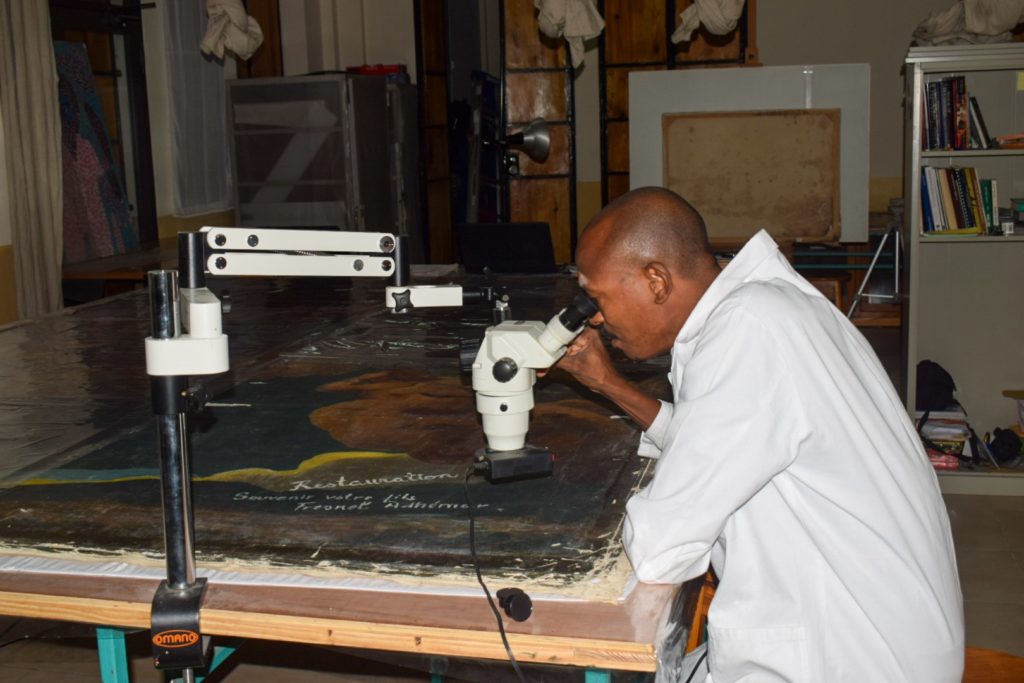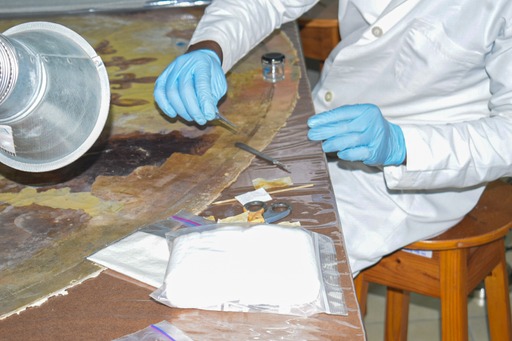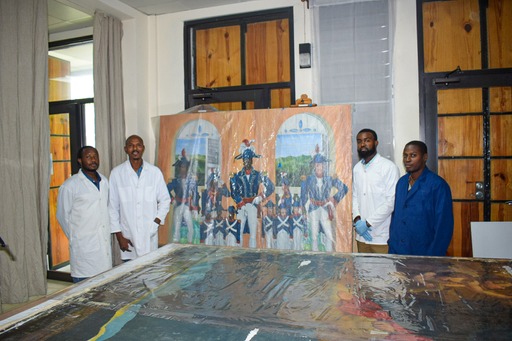This post is also available in: Kreyol
“Our cultural artifacts serve as a testimony of our identity as a people. It is imperative that we save and conserve our cultural heritage because it drives us to hope and anchors us in who we are. If we don’t preserve our cultural artifacts, we will lose bits of who we are. Each generation will pass, and there will not be any link from one generation to the next.”
– Erntz Jeudy

Sitting down with the lead art conservator, Erntz Jeudy, at University Quisqueya’s Cultural Conservation Center (Centre de Conservation de Bien Culturels, CCC) was an eye-opening experience. Art conservation is seldom discussed in our day-to-day life, though its role is pivotal in preserving our history and identity. Jeudy, a slim astute gentleman enthusiastically shared about his work as an art conservator–a rare trade within the creative space in Haiti– the history of Haiti’s leading cultural conservation center, and what motivates him to continue this work in such a tough environment.
January 12th, 2010 is the day all Haitians will never forget. The disastrous earthquake of 2010 not only took with it so many of our loved ones, but also damaged thousands of archives, collections of artworks, and artifacts that have shaped our cultural heritage for centuries. These artifacts do not simply document our people’s history but reflect our values of dignity, freedom, self-reliance, community, faith, and creativity.
The Cultural Conservation Center (CCC) was initially set up as part of a bigger project the Haiti Cultural Recovery Project by the Smithsonian Institution (SI) in partnership with the Haitian government in an effort to preserve the many cultural artifacts heavily damaged after the events of January 12th. Within the first few years, the Smithsonian and its partners saved and treated over 30,000 paintings, sculptures, artifacts, rare books, murals, and archival artifacts and trained over 100 Haitians in basic art conservation work. Initially housed downtown Port-au- Prince in a former U.N. building by the summer of June 2015, a permanent conservation center was inaugurated at University Quisqueya. This was made possible by the generous support of University Quisqueya, the Smithsonian, USAID, and the Stiller Foundation.
Following the inauguration of the center at the university in 2015, the center was led by Franck Louissaint. Frank Louissaint, an acclaimed artist, and teacher, was one of the first generations of artists in Haiti to specialize in art conservation. After his passing in 2021, Mr. Erntz Jeudy, a faithful mentee and student of Franck Louissaint went on to follow in his footsteps. The CCC team of art conservators is four people strong and currently includes Mr. Erntz Jeudy, Mr. Richard Ruthger, Mr. Marc Gérard Estimé, and Mr. Godson Antoine.

Mr. Jeudy went on to explain his ongoing love and commitment to this work.
“My life wouldn’t have real meaning if I did not contribute to preserving our culture, our identity… I love what I do because I love myself. I love myself because I love my origins. Loving my origins means that I love my country. To say I love my country means I love my story, our history, and our identity. For this work to have meaning, for me, it is because of these testimonies, these artifacts. I will also pass on, but these will remain. This work is not only for this generation but for generations to come.”
Mr. Jeudy continues to work on various pieces across the country, restoring artifacts dating over 200 years, such as the restoration of the Palais Sans Souci painting by Numa Desroches from 1818. The process undertaken for each artifact is a delicate one, often spanning months of focused attention dependent on its level of deterioration. Each piece shares its own story and requires varying degrees of intervention. Jeudy’s team focuses on preserving the original work.
Many steps are employed in the restoring process, and this can include cleaning, repairing, and, oftentimes, removing old restoration attempts. This was the case with the life-sized painting titled Ascension that came from the Cathedral of Cap Haitian. This masterpiece had undergone restoration in the past, disfiguring the original work and altering the piece’s integrity. Mr. Jeudy explained that as a conservator, you often must wear many hats and work with great detail. Their intention is to improve the condition of the work by stabilizing physical problems and addressing any surface disfigurement arising from deterioration or damage.

Recurring natural disasters, persistent socio-economic instability, and ongoing political instability force Haitians to survive in very difficult circumstances. Prioritizing our basic needs, we often forget just how important cultural expression throughout our history has been to our survival. The reality is that, throughout the hardships that we have lived through, we never forget our culture in times of uncertainty. Instead, we take refuge in it. We pray harder, sing louder and hold on tighter to each other. Art serves as a mechanism to preserve our identity and cultural expression.
The CCC is designed as a space for exchange, training, research, exhibition, and discussion of ideas on the place and role of culture in economic development. Today, the center is doing the work of commissioning pieces from all over the country and is currently working to extract art damaged by the August 2021 earthquake in the southern departments of Haiti.
If you are interested in learning more about their work please visit https://uniq.edu.ht/ccc/presentation/
Photos by Cassendy Lafond
